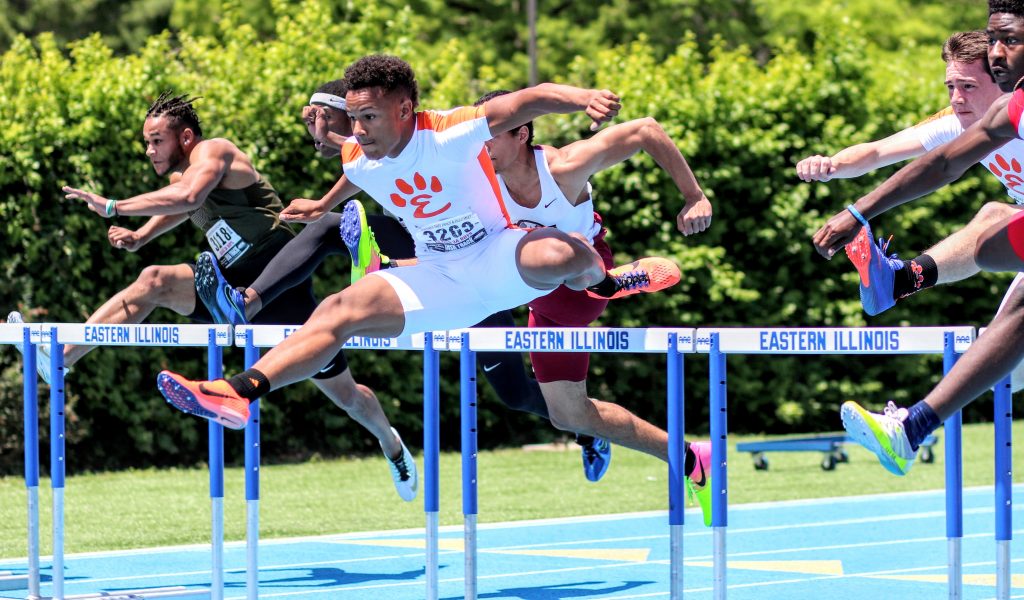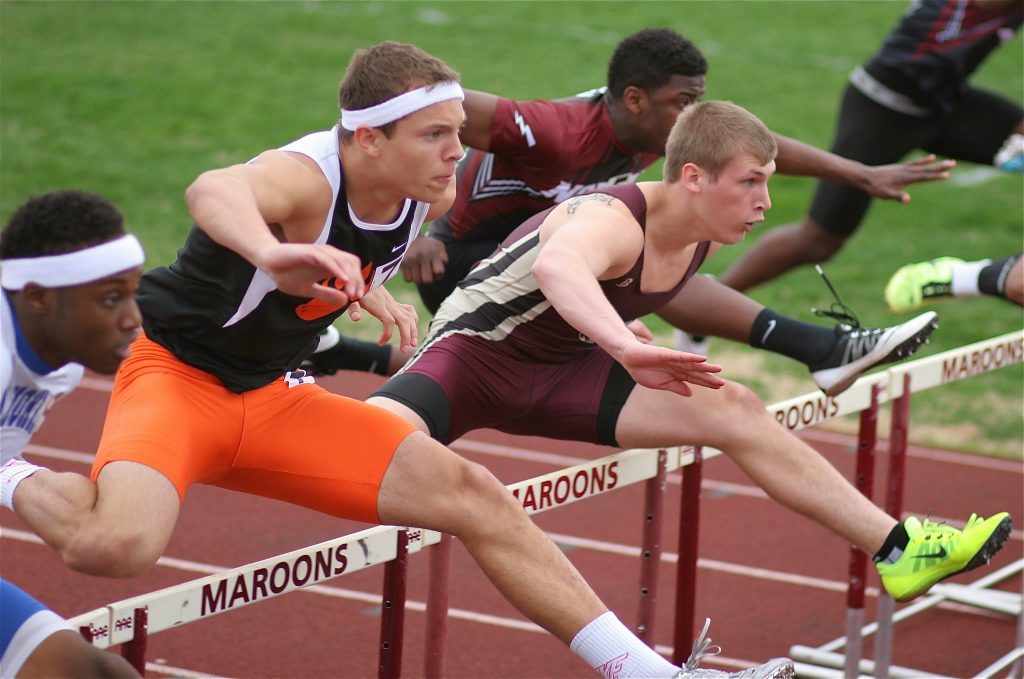
A Hurdle System for Cats
(by guest blogger, Alec Holler, Edwardsville High School)
When I first started writing this article, it was in response to a TFC article comment: “How do you feed the cats that hurdle?” My dad (Tony Holler) asked me to respond. My initial response was to first train them as sprinters. Once you get into the season, hurdle them with low reps twice a week. The more I thought about it, the more I felt the need to go more in depth.
Many event coaches (especially in college) call themselves “low-dose” and are kidding themselves. I see hurdle coaches constantly working hurdle endurance. Some college coaches do 100 hurdle warm ups (I did in college). When you stack endurance-training on top of high-quantity warm ups on top of sprint-training, you end up with hurdlers with bad mechanics and broken bodies.
Hurdle coaches are not the only volume offenders. Most jump coaches do too many drills and too many reps. Jumpers were never meant to do dozens of jumps and hundreds of drills day after day after day. Like hurdlers, the result will be bad mechanics and broken bodies.
The parameters of “low-dose” are undefined. Maybe we should think in terms of “minimum effective dose”. Maybe we should push the limits of how little we can do. Maybe we should experiment with “micro-dosing”.
This article will focus on effectively coaching hurdles without too much volume. Hopefully, some points I make will be translatable to other events as well.
When should I start hurdling?
I have my work cut out for me this year.
I lost my four excellent hurdlers from last year’s team:
♦ 13.59/37.83 (3x State champ, state record holder)
♦ 14.35/39.55 (third place at state)
♦ 15.13
♦ 15.53
With basically no returning hurdlers, I am trying to convert second-class sprinters who won’t make our relay teams into hurdlers.
It would be easy to panic and have them all start hurdling in the summer or in the fall as soon as football ended. That’s not what we did. My hurdlers focus on football in the summer and fall. We don’t do summer track in Edwardsville.
It’s important to treat your hurdlers as sprinters first and foremost. Pure speed was the focus during the entire preseason. We didn’t have a single hurdle practice until three weeks before the first meet. Speed is the #1 priority in hurdling. Speed is hard to practice in-season. With track meets, lactate workouts, and event training, speed takes a back seat in the months of March, April, and May.
When I say “speed work”, I’m not just talking about sprinting. We also work on coordination, stability, hip mobility, and functional strength … which are all important components of hurdling. Besides, fast guys pick up hurdling quicker than slow guys.
Weekly Programing
For hurdlers in-season, I try not to hurdle more than twice a week. Sometimes that’s impossible if there are two meets in a week, but you can also adapt and adjust. Don’t hurdle every single meet. Give your hurdlers a lighter load or a different event in a meet once in a while. If they must hurdle in four meets in two weeks, cut out your hurdling in practice. Instead, do low-impact drill work.
Weeks where you hurdle three times need to be rare and limited. Over-trained hurdlers break. Prioritize rest. Micro-dose.
A sample week for me would go like this:
♦ Two hurdle days (practice or meet)
♦ One true speed day (like 3x 10m fly)
♦ One lactate day (with the sprinters)
♦ One no-sprint day (X-Factor day, mini hurdles, drills, plyos, etc)
♦ Two rest days
What does a typical hurdle day look like?
You will never see me make a season outline with a workout for every single day of the season. There are too many variables to consider. Track coaches must adapt to the health of their athletes, weather, and God knows what.
With that said, I go by a few guidelines:
♦ We do our low impact hurdle drills every hurdle practice.
♦ We never go over more than 2 hurdles per rep. Anything beyond that is redundant and unneeded pounding. If your hurdler is falling apart late in the race IT’S NOT AN ENDURANCE PROBLEM. Usually it’s a “cut-step” problem that can be fixed by going over one or two hurdles correctly. I usually alternate doing just the first hurdle one practice and the first two hurdles the next.
♦ Keep the reps low. Don’t nitpick your hurdler making them do multiple reps to fix something small. If they have two near-perfect reps, cut them off. If they are dying for more reps due to a lack of confidence, end on a good one and try to keep it under six total reps.
♦ Always discount the second hurdle. Never go over race height.
♦ Always wear spikes. Hurdling is sprinting, not running.

(above – Travis Anderson, Illinois HH record, 13.59)
In your hurdle practices, it’s important to get maximum effort out of your kids. If you simply have them run through hurdles, that is exactly what they will do. Running is not sprinting. Most hurdle drills unwittingly promote bad habits. Stay away from them. The extra pounding isn’t worth it.
We modify the Feed the Cats pillar of “Record, Rank and Publish”. I time reps every day (touchdown times). I record their reps on my “Hudl Technique” app on my phone and we watch the rep frame by frame and talk about it. All the kids know their times. I know the PR for every hurdler I coach.
Keep your kids confident. Coaches have a tendency to ruin confidence by over-coaching. Rarely do you see a perfect hurdle rep. Stop pointing out every little thing they do wrong. Your kids will lose confidence and fall apart. I spend most of my time convincing kids how good they are, even if they aren’t. Hurdling with confidence fixes a lot of issues.
How do you train for the long hurdles?
We practice the 300 hurdles as little as possible. Seriously. I have tried every long hurdle training method I have found. I have added lactate workouts to my hurdler’s regular sprint-training workload. I have added a hurdle into preexisting lactate workouts. I have had my hurdlers run the full 300 race in practice. I’ve even added an aerobic component (cringing) to simulate being tired to practice the last few hurdles.
We still had stuttering. We still had hurdlers that ran out of gas the last 100 meters. Worst of all, my hurdlers were slower, injured, and broken down.
I found the minimum effective dose out of bad luck. Isaiah Michl would have absolutely broken the state 300m hurdle record. He was at 30.8 seconds on touchdown after the second to last hurdle of a race in early April. Isaiah had a little more than 40 meters to go. He seemed to be gaining speed on the homestretch. All Isaiah had to do was run 5.0 seconds for the last 40 meters to break 36 seconds. Instead, he pulled his hamstring (for a third time) as he was in the air over that seventh hurdle.

(above: Isaiah Michl, now running at the University of Illinois)
Due to these hamstring injuries, we had to keep pushing the limits of minimum effective dose. Isaiah Michl placed third in the state with only five 300m hurdle practices his senior year. His only focus was on the first hurdle or the first two. Isaiah had no high hurdle workouts as a senior.
The conclusion? If you are able to maintain momentum through the first two hurdles (no stuttering, no reaching), then re-accelerate at the curve, your steps will be fine for the next 6 hurdles as well.
I’m still haunted by the day Isaiah was on pace to run a state record in the 300m hurdles. His best time ended up being the 37.13 he ran in March. Isaiah ran 38.00 at state to finish third, running at about 75% strength.
300 hurdle state champion Travis Anderson would do anything to avoid a lactate workout and battled injuries as well. Travis ran 37.83 without ever breaking 51 in the 400 and only running in two lactate workouts all year. It didn’t matter because his steps were always on target.
Keep your hurdlers happy, healthy, and confident. When it comes to dosage, always err on the side of less.

Alec Holler can be found on Twitter @a_hollerEHS


Thank you for putting down in writing what I have been looking for the past 3 years! This gives me a framework for how to work with my varsity hurdlers. I also follow Hector Cotto who has some fantastic drills for teaching 3-step hurdling on up to advanced stuff. Very easy to understand. Thanks again for your insights.
Thank you! I will look him up.